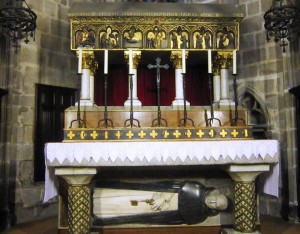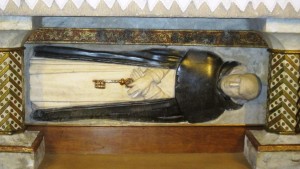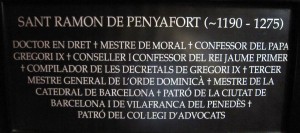Tomb of Saint Raymond of Peñafort, Barcelona, Spain.With the permission of one of our parishioners who shared this with us, below are pictures of his tomb in the Cathedral.
The Cathedral of the Holy Cross and Saint Eulalia also known as Barcelona Cathedral, is the seat of the Archbishop of Barcelona, Spain. The cathedral was constructed from the 13th to 15th centuries, with the principal work done in the 14th century.
Every 7th of January the feast day of Saint Raymond of Peñafort, patron saint of Canon lawyers, is celebrated at the Cathedral of Barcelona, where his tomb is located.
Saint Raymond of Peñafort was born in Santa Margarida i els Monjos, at the castle of Peñafort. His father’s castle was located a few miles from Barcelona, a city of Catalonia in Spain. The castle was built on rocks which rise from the waters of the river Monjos. A Dominican priory, built in 1601, on the site of the castle, still remains. “From his infancy he was blessed by God. “Although in years a child, his heart was that of an old man.” per one ancient author. (Dominican Saints of the Rosary Series p.3) He was a student at the school of the Cathedral of Barcelona.
From childhood he had a tender love and devotion to the Blessed Mother. He finished his studies at an early age, and became a famous teacher. He then gave up all his honors and entered the Order of the Dominicans. St. Raymond was very humble and very close to God. He did much penance and was so righteous and kind that he won many sinners to God.
With King James of Aragon and Saint Peter Nolasco he founded the Order of Our Lady of Ransom. The brave religious of this Order devoted themselves to saving poor Christians captured by the Moors.
He studied law at the university of Bologna. He was also and advisor and confessor to the Pope in Rome, as well as to kings and, especially, to James I of Catalonia and Aragon.
Knowing Raymond’s reputation in the juridical sciences, Pope Gregory IX summoned him to Rome in 1230 to help in the rearranging and codifying of canon law. Canon laws, which were previously found scattered in many publications, were to be organized into one set of documents. In particular papal decretal letters had been changing the law over the course of the previous 100 years since the publication of the Decretum of Gratian. Being pleased with Raymond’s efforts, the pope announced the new publication in a Bull directed to the doctors and students of Paris and Bologna in September 1234, commanding that the work of Raymond alone should be considered authoritative, and should alone be used in the schools. His collection of canon law, known as the Decretals of Gregory IX, became a standard for almost 700 years. When Raymond completed his work, the pope appointed him Archbishop of Tarragona, but he declined the honor. Raymond followed this with the publication of a work on penitential discipline, Summa casuum, which is widely considered an authoritative work on the subject. Canon law was finally fully codified by 1917.
He also wrote works on confession and on marriage.
Raymond had written for confessors a book of cases, the Summa de casibus poenitentiae. More than simply a list of sins and suggested penances, it discussed pertinent doctrines and laws of the Church that pertained to the problem or case brought to the confessor. One result was that Pope Gregory IX summoned Raymond to Rome to serve as his personal confessor. In 1230 the pope asked Raymond to organize the myriad of decrees in canon law in the 80 years since the publication of the Decretum Gratiani. The result was the Decretals, issued in 1234.
His Summa de Poenitentia et Matrimonio is said to be the first work of its kind.
Raymond was appointed to the position of Archbishop of Tarragona, the capital of the Kingdom of Aragon, over his strenuous objections. He did not appreciate the honor bestowed on him and ended up getting sick and resigning within two years. Raymond returned to Barcelona in 1236. Not long able to remain in seclusion, however, he was elected the Master of the Order of Preachers by the General Chapter of 1238. He immediately set out on foot to visit all the houses of friars and nuns of the Order. Even in the midst of this, he was able to draft a new set of Constitutions of the Order, in which he included a resignation clause for the Master. When it was adopted by the next General Chapter of 1240, he immediately took advantage of that option.
Rejoicing to see himself again free of office, he applied himself with fresh vigor to the Christian ministry, especially working for the conversion of the Moors. To this end he encouraged Thomas Aquinas to write his work Against the Gentiles. He instituted the teaching of Arabic and Hebrew in several houses of the friars. He also founded priories in Murcia (then still ruled by Arabs) and in Tunis. Additionally he went to help establish the Church in the recently conquered island of Majorca.
Once he went with King James to the Island of Majorca to preach about Jesus. King James was a man of great qualities, but he let himself be ruled by passions. There on the Island, too, he was giving bad example. The Saint commanded him to send the woman away. The King said he would, but he did not keep his promise. So St. Raymond decided to leave the Island. The King declared he would punish any ship captain who brought the Saint back to Barcelona. Putting all his trust in God, Saint Raymond spread his cloak upon the water, tied up one corner of it to a stick for a sail, made the Sign of the Cross, stepped onto the cloak, and sailed along for six hours until he reached Barcelona. This miracle moved the King. He was sorry for what he had done, and he became a true follower of St. Raymond.
Another one of his principal aims became to convert Jews and Muslims to Christianity, and for the furtherance of this aim he caused both Arabic and Hebrew to be studied and taught in the higher schools conducted by Dominicans, the Studia Linguarum. He also encouraged Thomas Aquinas to write his work Summa contra Gentiles.
He exercised great influence over King James of Aragon and succeeded in persuading him to order a public debate, concerning Judaism and Christianity, between Moshe ben Nahman, a rabbi in Girona, and Paulus Christiani, a baptized Jew of Montpellier who belonged to the Dominicans. In this debate, which took place in the royal palace at Barcelona from 20–24 July 1263, in the presence of the king and of many of the higher clergy, Raymond took an important part. He was at the head of the theologians present, and in agreement with the king gave the rabbi perfect freedom of speech. Raymond simply observed to Moses ben Nachman that he must not allow himself to blaspheme Christianity, to which Moses replied that he knew what the laws of propriety demanded. On the Jewish Sabbath following the close of the debate, the king, together with many preaching friars and other clergy, visited the synagogue. There, Raymond delivered an address on the Trinity, which Moses ben Nachman denied.
He was among those who established the Inquisition in Catalonia.
Raymond died at the age of 100 in Barcelona in 1275 and was canonized by Pope Clement VIII in the year
1601. He was buried in the Cathedral of Santa Eulalia in Barcelona.
Like many of the Dominican saints, Saint Raymond is as widely known for his learning as for his sanctity. the four characteristic marks of the true Dominican: devotion to the Blessed Virgin, consummate holiness, elevated learning, and burning zeal for the salvation of souls, are to be found in him in perfection.
Below is an invitation to each of us to participate in proclaiming the Epiphany in our own simple lives.
“Look then on Jesus, the author and preserver of faith: in complete sinlessness he suffered, and at the hands of those who were his own, and was numbered among the wicked. As you drink the cup of the Lord Jesus (how glorious it is!), give thanks to the Lord, the giver of all blessings. May the God of love and peace set your hearts at rest and speed you on your journey; may he meanwhile shelter you from disturbance by others in the hidden recesses of his love, until he brings you at last into that place of complete plenitude where you will repose for ever in the vision of peace, in the security of trust, and in the restful enjoyment of his riches.”
– Saint Raymond of Peñafort






